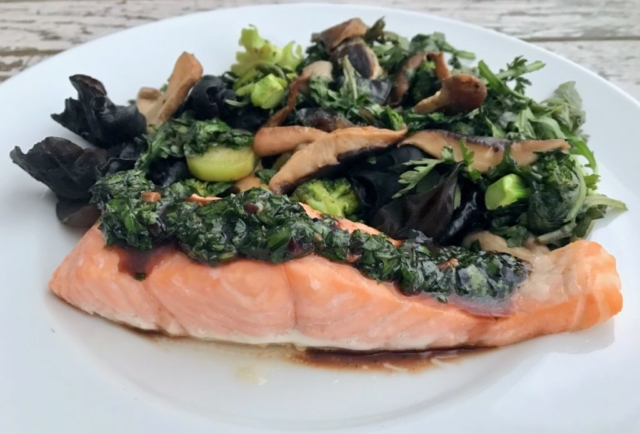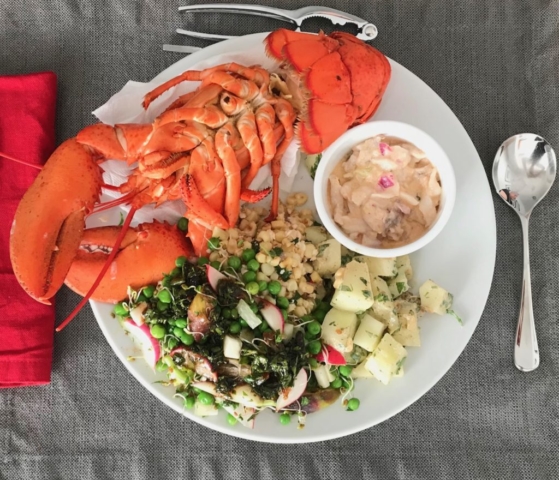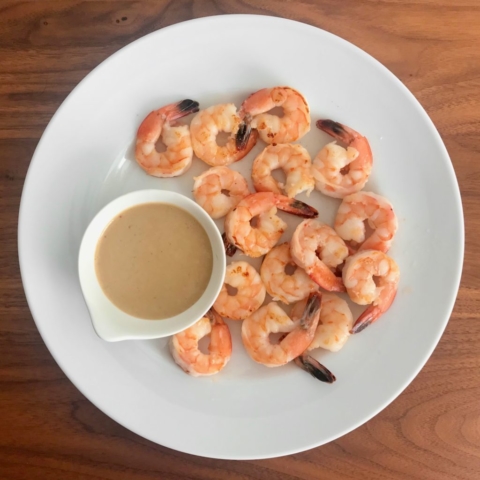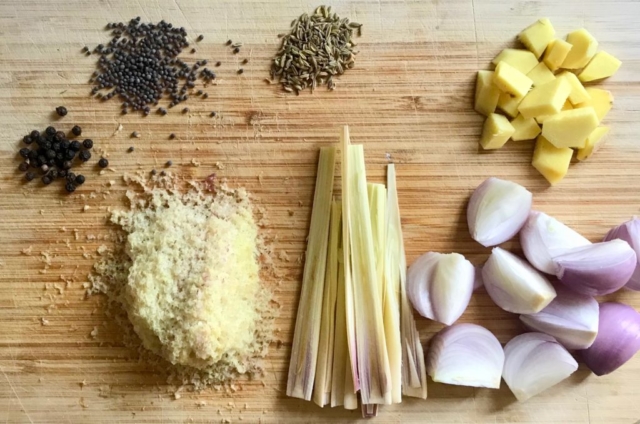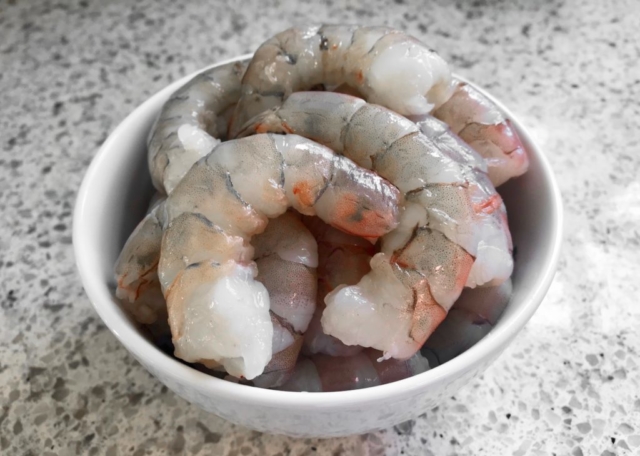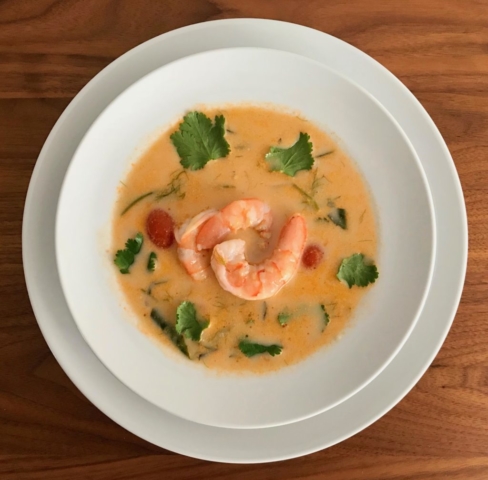
Gather & Graze: 120 Favorite Recipes for Tasty Good Times
Stephanie Izard with Rachel Holtzman
Photographs by Huge Galdones and styling by Johanna Lowe
2018
Purchased from Now Serving in downtown Los Angeles
Recipes cooked: Thai-style bouillabaisse, shrimp cocktail with miso blue cheese sauce, salmon with blueberry-Szechuan chile sauce, “tasty eggy kimchi bacon thing,” Szechuan chile sauce, sauce green, smoked salmon toast with chile-lime vinaigrette (as a salad), aioli (only) from recipe for goat neck with pickled watermelon rind salad
Recipes I want to cook: Whole roasted lamb shoulder with mint chimichurri, hamachi collar with unagi mayo and heirloom salad, goat-o goat-o Malaysian inspired salad, chocolate peanut butter covered Cheez-It s’mores
Difficulty to source: Easy to medium
Difficulty to make: Solidly medium
Smoked salmon with chile-lime vinaigrette, fennel, and summer fruits
I read Chef Stephanie Izard’s Gather and Graze on a cross country flight from California to North Carolina for a cousin’s wedding in May, and by the time I landed, almost every other recipe had a torn strip from a Delta Airlines cocktail napkin bookmarking it.
The first was a smoked salmon toast with sambal oelek, fish sauce, blackberries, fennel, and cream cheese. The next combined good blue cheese, white miso paste, spicy harissa, lime juice, and Shaoxing wine, a Chinese cooking wine that tastes, to me, like woody dry sherry, celery leaves, and maple syrup, as a dipping sauce for shrimp cocktail. The third was for a grilled bok choy and cashew salad, wherein vinegary pickling liquid, kalamata olives, fish sauce, tarragon, and ginger come together as a dressing.
I marked the recipes because the ingredients seemed so unlikely to complement each other that I wanted to make them almost more for experimentation than enjoyment. It was neither my kindest nor my wisest inclination, because the napkins have since been replaced by torn strips of thick note paper that can better withstand the book’s near constant use.
Something I don’t volunteer about myself is that every morning, I endeavor to eat only Eastern or only Western foods until I go to bed—I call it “theme days” instead of what it is, a mild obsessive compulsion that no therapist of mine has ever minded. Think of the dandelion. It’s a weed by reputation and also a food, medicine, and companion plant in practice all at once. Who’s it hurting? Theme days often inspire the best of my creativity in my cooking, motivation to learn about the origins of foods, and restraint in offices with constant “treats” at meetings that are well intentioned but, well, excessive.*
Gather and Graze makes living out my theme days all but impossible. So, it’s with not a marginal amount of relief that I tell you that the cookbook is freeing for me, with Izard’s seemingly impossible amalgams of ingredients from around the world. Izard is the 2013 James Beard Foundation’s Best Chef in the Great Lakes region, for her Chicago restaurant Girl and the Goat; she is as successful as a TV personality, as the 2008 Top Chef winner and, as of 2017, an Iron Chef. This cookbook could be as difficult to cook and as technical to read as she felt like making it, and she and her team made it approachable and fun instead. I have more than a hundred oils, vinegars, sauces, pastes, and spices between my refrigerator and pantry, and here, they come together in equal parts unexpected and extraordinary.
Salmon with blueberry-Szechuan chile sauce, and Asian greens
I’ve now made the salmon with blueberry-Szechuan chile sauce twice, and just the sauce a third time as a salad dressing. The sauce is western Chinese and southeast Asian and Mediterranean—broad bean paste (doubanjiang), fish sauce, vinegar, sesame oil, chile oil, fresh parsley, sesame seeds, ground Szechuan peppercorn, and, yes, blueberry jam. I made it for a friend, who liked it, and wisely observed that it wasn’t unlike hoisin sauce.
I did the salad dressing iteration for my mom, visiting Los Angeles from the east coast; she copied the recipe on note paper and ordered a couple of ingredients from Amazon while reclined on my couch the next morning, then replicated it within a week of flying home from. I used to buy fruit preserves only for her every-other-year-or-so trips, letting the sticky-lidded jars languish on the bottom shelf of the refrigerator door with other condiments I’ve used once or not at all before wistfully throwing them away months after their due, with little swirls of butter from a double-dipped knife still decorating the surface. But this blueberry jam jar has since moved up to the Western shelf, and it would be welcome on the Eastern shelf if it had the space.
Gather and Graze is divided into chapters for brunch, grilling, meat, seafood, vegetables, and desserts, with a short chapter for pickles at the end. The main chapters each include additional recipes that complement each other for entertaining, listed in a smaller font. I fear that, for example, the recipes for Chef Kevin Willmann’s fish gumbo and the miso butterscotch budino offered in the “gimme meat” chapter’s “goats go mo” party menu will be overlooked, where they’d stand out in the respective seafood and dessert chapters.
But it’s okay—really. Unless all recipes are listed upfront in a cookbook (rare today), you’ll consult the index for recipes, and where they appear in the book becomes irrelevant. The page numbers for the gumbo recipe can be found under both “fish” and “gumbo” and for the budino recipe under “dessert” and also “miso” and “butterscotch” and “budino” in the back. You’ll get there!
Miso blue cheese everything
Cookbooks representing a singular region, restaurant, or chef tend to have a lot of ingredient overlap from one page to the next, and for Gather and Graze, you’ll want fish sauce, sambal oelek, Shaoxing wine, garlic, chiles, lime, and salty cheeses. Did I mention vinegar? It will help if you keep around malt, white, red wine, rice wine, and sherry vinegars. The flavors are bold, and, both in spite of and because of all of the acid and salt and spice, balanced.
The shrimp cocktail with miso blue sauce is inevitably across the map. I wanted to make it because I’d accepted a certain pretension about not combining seafood and cheese in adulthood, after an entire childhood spent plotting ways to get my next McDonald’s Filet-O-Fish sandwich with its gooey square of American cheese, and Outback Steakhouse’s creamy Parmesan Queensland shrimp fettuccine alfredo, and—my favorite all through high school—a made-to-order salmon salad sandwich with melty dill havarti cheese and spicy dill sauce from Olde Towne Wine and Cheese in downtown Fredericksburg, Virginia. I worked the desk at a hair salon across the street after school and on weekends, and I’m smiling now, thinking of how the chemicals we breathed in from perms, bleach jobs, and acrylic nails met their match in a salmon melt in the break room.
“Tasty egg kimchi bacon thing”
The miso blue sauce recipe made a lot of dressing, so I had it twice with shrimp and finally as a dressing for a homemade swordfish salad. It kept well over several days, and I liked it.
Same for the “tasty egg kimchi bacon thing” and smoked salmon with chile-lime vinaigrette. Izard describes the tasty thing as “a pillowy, crispy-edged crepe (kinda like a cross between funnel cake and a pancake)”, which I can see, but its main ingredients are equal parts kimchi, eggs, all purpose flour, rice flour, and cornstarch—yes, that much cornstarch—and yes, that much kimchi, too—so it is inevitably gummy and sour. I think the texture could be very lovable for a lot of people. I modified the smoked salmon dish to make it a salad, which made the vinegary sambal oelek, tart lime juice, briny fish sauce, smoky salmon, and salt-to-taste that much more pronounced. Even with fresh berries, fennel, and herbs to temper the flavors, it was almost too much, so, as with all recipes, we stray at our own risk.
Thai style bouillabaisse
My favorite of everything, though, was the Thai style bouillabaisse, a cross between the French fish stew and Thai tom kha, two soups that loathe being categorized as such because they can be as complicated and flavorful and rich as a deft chef desires, and Chef Izard is deft AF. If you’re feeling a little exasperated that I won’t describe this one in detail, good. I’d rather you buy the cookbook and have the same experience that I had on that airplane. It could change you forever, for the best. As things go in life, you’ll never know until you try.
–
*In eight years of doing events for universities with blue as a school color, all of my bosses gave me the birthday gift of team meetings without cakes, especially cakes with blue food coloring saturated roses bleeding into pristine white buttercream surfaces; there was never a cake even once, though I’d never said anything, and I knew they understood me. One brought in assorted hummuses and crackers and vegetables, another gave me the day off each year she could manage it, and a third filled in for an event for me. 🙂














